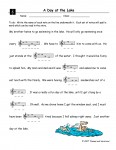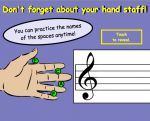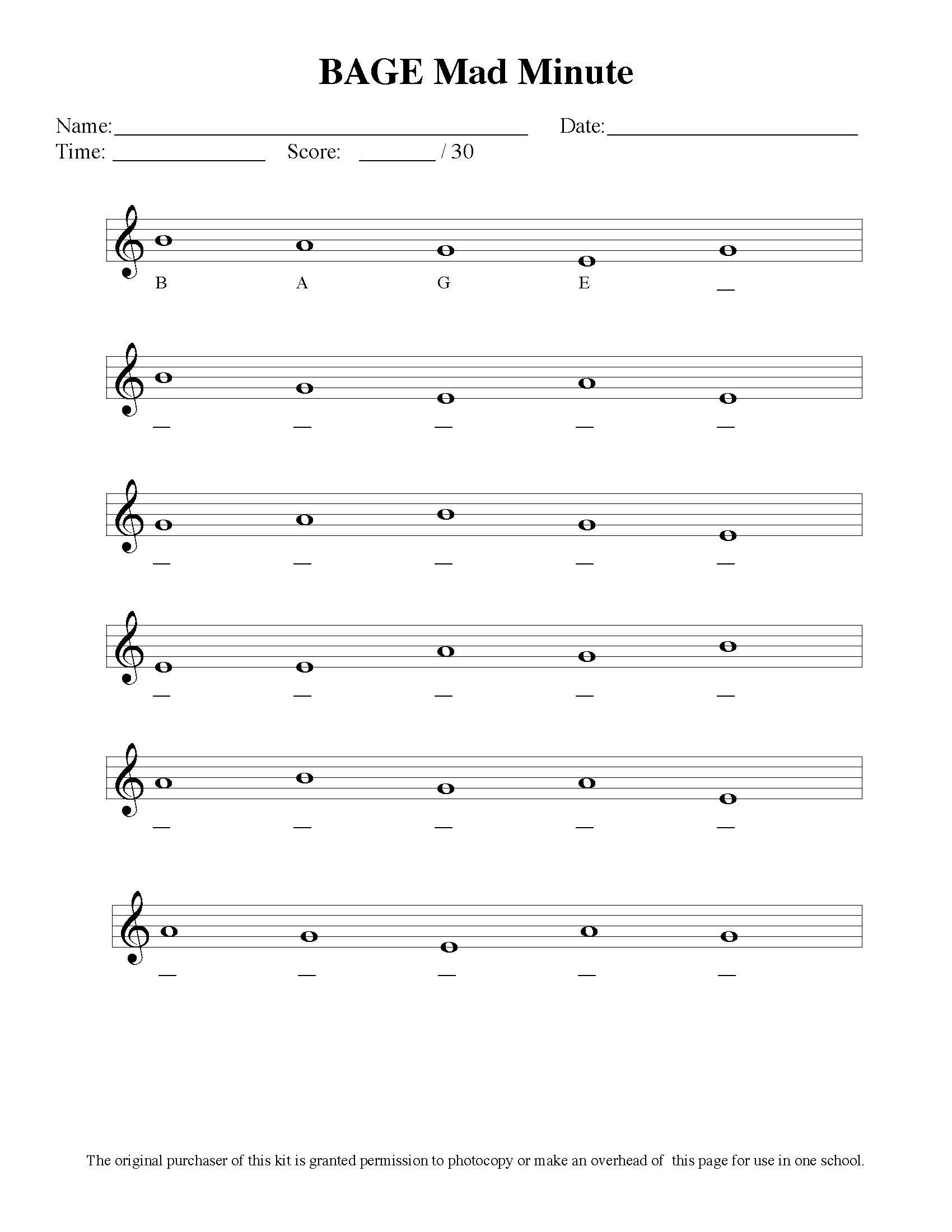Fun Ways to Teach Note Names
This post is all about fun ways to teach children the letter names of the notes. When you play an instrument, it’s a very useful skill to know the name of the note on the staff so that you know which of the bars you should play! To be a good sight-reader, you need instant recall. You can’t be counting the lines and spaces on your hand staff if you want to be a fluent sight reader. So how do we get kids to develop fluency in reading music?
There is a great staff lesson in lesson one of Musicplay 4.
The Staff: Music is written on a 5 line staff. Notes can be placed on lines or in spaces. The lines and spaces are numbered from the bottom to the top. At the beginning of a staff, a clef is given. The treble clef circles the note G, and is used for treble, or higher notes. A high pitch is shown by placing a note high on the staff. A low pitch is shown by placing the note lower on the staff.
I like to start by introducing the lines with the hand staff. Draw a staff on the board about the size of your hand. Then, hold your hand up to the staff and point out that you have five fingers, just like there are five lines on the staff.
Hand Staff: Show the students the hand staff. Hold your hand in front of you with your fingers spread apart and the thumb up. Number your fingers 1-2-3-4-5 from the bottom to the top. Tell the students that they have five fingers, just as there are five lines on the music staff. To show the spaces on the hand staff, place the index finger of your right hand between two fingers. Spaces are also numbered from the bottom to the top. Call out a line or space and have the students point to the correct one. For example: line 3, space 4, line 1, space 2
My hand fits nicely on my cookie sheet staffs, so kids see the relationship between your hand and the staff. If you don’t have cookie sheet staffs, draw the lines on the board.
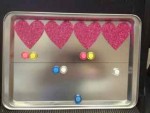
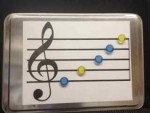
Some teachers like to have the students practice naming notes on lines and spaces. Make up poems or sayings to help them remember the names of the notes. For example: The notes on the lines spell, “Every Good Boy Does Fine.” Kids can make up their own sayings. Some of the best I’ve heard are “Elvis’s guitar broke down Friday” or “Empty Garbage Before Dad Flips.” The notes in the space, spell “face.”
I like to move from notes on lines and notes on spaces to the full staff quickly. They won’t be fluent readers by practicing lines only or spaces only. When they understand that the notes go step by step from letter to letter, CDEFG, they are on their way to fluent reading.
I introduced the staff, taught the hand staff, practiced notes on my cookie sheet with a grade 3 class, then had them play the first 7 songs from Teach Music Reading with Boomwhackers. In a 30 minute lesson, they were able to begin to read the notes and to play Jingle Bells on Boomwhackers. The projectable for Teach Music Reading with Boomwhackers includes an introduction to the staff and the songs include a version with alpha-notes or kids notes: the letter name is imprinted on the note AND a version with colored Boomwhacker notation. Even so, I was very pleased that the students were able to read simple songs in just one lesson.
Link to Teach Reading with Boomwhackers USA site Link to Boomwhackers Canada site
Floor Staff Games: Use painter’s tape to put a giant staff on the floor. Painter’s tape won’t hurt the carpet and will last for a week or two until you’ve taught the staff games to all your students. If you have funding available, you can purchase a music rug to go on the floor that has a staff built into it. Visit www.musicplay.ca to see a music rug. Additional staff games are given in the publication “Staff and Symbol Games.”
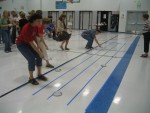 Link to Staff and Symbol USA site Link to Staff and Symbol Canada site
Link to Staff and Symbol USA site Link to Staff and Symbol Canada site
1. Staff Jump
An elimination game to learn the names of the lines and spaces. Have half of your students stand on line one. Call out a line for them to jump to – line three! line four! The last student to get to the correct line is eliminated. Have the other half of your students jump to the spaces. When you introduce the letter names of the lines and spaces, repeat the game using letter names.
2. Letter Names Jump
Group one will jump the lines on the music staff. The teacher calls out a line note – E, G, B, D, F – and the students jump to the line that she calls. To play this as an elimination game (optional), the last child to land on the line that is called is out. The last child left after the eliminations is the winner. Group two will jump the spaces on the music staff. The teacher will call out a space note name – F, A, C, E. If groups are small, repeat the note names and jump as needed until all the children have had a turn. When the students are very confident jumping lines or spaces, have each group jump to the note name that is called using both notes that are on lines and in spaces.
3. Staff Relay
Divide the class into two-four teams. On small paper plates write a letter name of a note – A B C D E F G. Each team is given a pile of notes. Teams race to place their notes on the correct line or space of the floor staff. The first team finished with ALL notes correctly placed wins.
When beginning recorder, you can introduce the notes one at a time. This really helps the students to “get it.” After introducing BAG, I have start having the students complete mad minutes to practice just those notes. Isolating the notes I want them to practice helps them become fluent reading those notes.
MAD MINUTE SAMPLE
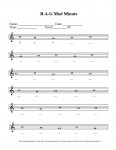 Mad Minutes are included in the Recorder Resource Kit, with a new mad minute for each new note that is introduced. The note name mad minutes are used for the same reason that teachers use math mad minutes. Children will only learn to read music well if they have instant recall of note names. I shrink the pages 50% so I can fit two on a page, and double-side them to save paper. We do each mad minute twice before going on to the next level. For evaluation, I cut the tops off the mad minutes so that the answers are removed. I also drill note names with the class sized flashcards. I begin the mad minutes before the students have their recorders. I allow three minutes to complete each mad minute. I time the students, and they try to beat their own best time – not race each other. When they finish, they call “done” and I tell them how many seconds they took. If a student needs more than three minutes to complete the sheet, I give them a sheet for practice at home. Several teachers have told me that they put the mad minutes into sheet protectors and the students write on them with whiteboard markers and erase and reuse when completed.
Mad Minutes are included in the Recorder Resource Kit, with a new mad minute for each new note that is introduced. The note name mad minutes are used for the same reason that teachers use math mad minutes. Children will only learn to read music well if they have instant recall of note names. I shrink the pages 50% so I can fit two on a page, and double-side them to save paper. We do each mad minute twice before going on to the next level. For evaluation, I cut the tops off the mad minutes so that the answers are removed. I also drill note names with the class sized flashcards. I begin the mad minutes before the students have their recorders. I allow three minutes to complete each mad minute. I time the students, and they try to beat their own best time – not race each other. When they finish, they call “done” and I tell them how many seconds they took. If a student needs more than three minutes to complete the sheet, I give them a sheet for practice at home. Several teachers have told me that they put the mad minutes into sheet protectors and the students write on them with whiteboard markers and erase and reuse when completed.
- apps: Note Name Match Game, Note Name Squish
- Pop Quiz
- Solfa/Note Challenge
- Note Name Bingo,
- Note Name Battleship
- Music Centers
I’ve helped in the design of two apps for practicing note names: Note Name Match Game and Note Name Smash.
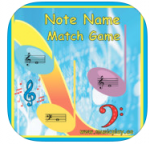
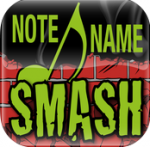
Note Name Match Game is a memory game with 10 levels – spaces, lines, staff, ledger lines – in both treble clef and bass clef. In Note Name Smash you can choose the notes you want to practice. Each note that’s correctly named smashes a hole in the wall. When all notes are correctly names, the wall crumbles – fun!!!
Our new online resource, www.musicplayonline.com has several interactive ways to practice naming notes. Musicplayonline is free to use until Aug.1 and then it will be a low cost subscription. If you or your school has purchased the Musicplay Digital resources, you will be eligible for a pro-rated credit to use the site at no cost. There will be an application posted on the site in August when it goes to the paid model and you can request free access. Each situation will be different, so every application will be looked at individually.
Pop Quizzes – these are fun and funny when the balloon pops! Students drag the correct letter to the balloon (that has the note) and each correct answer makes the balloon bigger. When all notes are correctly named, the balloon pops. Students drag letters to name the notes; then they drag notes to name the letters.
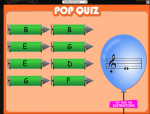
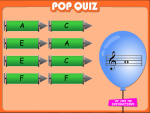
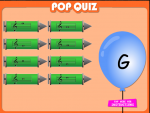
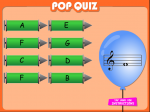
Note Name Challenge Activities
In this interactive activity, students drag a basketball to the net or a soccer ball to the net to name the notes in a reading song. If using this for the first time, be aware that the programmer made the upper left corner of the net the anchor for the note. As long as you have the correct note, and you touch that upper left corner, the note “sticks.” If it’s the wrong note, it flies away.
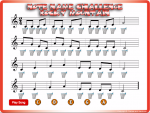
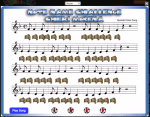
Music Centers
If you do centers in your classroom, the Music Center Kits 1 and 2 each include a note naming game. These colorful board games are easy to set up as centers and provide students with yet another way to practice naming notes.
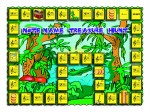 Note Name Battleship
Note Name Battleship
Have you played the battleship game? If you have, then note name battleship works the same way. On the top of the board place the notes that are your ships. On the bottom half of the board, you mark where you’ve guessed your opponents notes are placed. An incorrect guess turn the note over – a correct guess you mark with note facing up. The note name version of battleship goes a lot faster than the traditional game which is great when you have 30 minutes music classes.
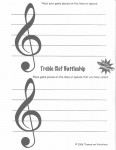 Note Name Bingo
Note Name Bingo
Note name bingo includes both treble and bass clef – great for teachers who want to teach both.
Know Your Note Names
This collection of 56 reproducible worksheets will give you a wealth of activities for practicing letter names. I like to make booklets of activities for my sub tub. It’s also great to have booklets made for when you do recorder testing. It’s also an alternative activity when a child is not able to participate in regular activities in music classes.
